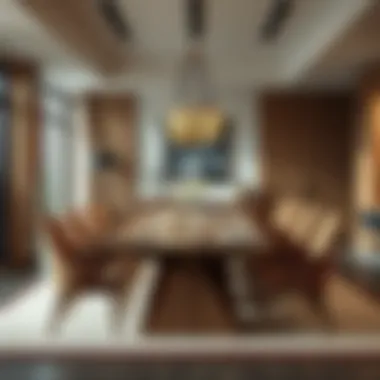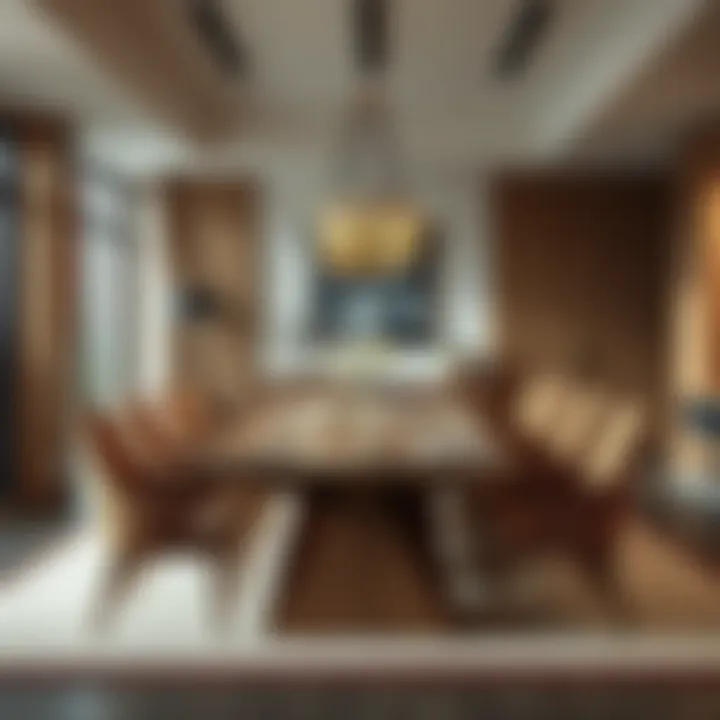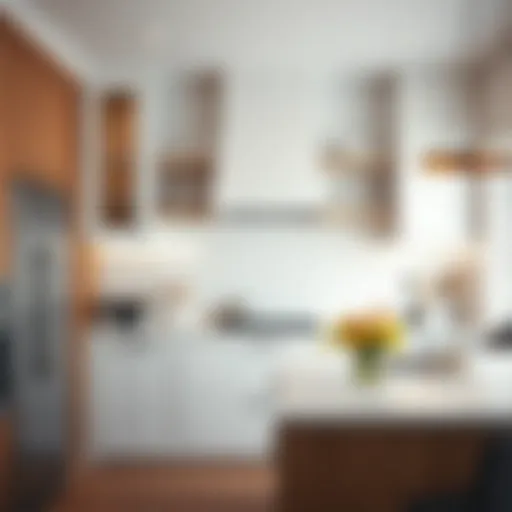Modern Dining Tables for Eight: Style and Functionality


Intro
The dining table often serves as the centerpiece of a home, a place where families gather to share meals and stories. When it comes to accommodating a larger group, a table that seats eight becomes not just a necessity, but a focal point for both functionality and design. Modern dining room tables have evolved significantly, embracing innovative designs that cater to diverse tastes and practical needs.
In this guide, we explore various aspects of dining tables that are suitable for eight individuals. From the latest design trends to material innovations, this comprehensive look will equip homeowners, interior designers, and decorators with insights into selecting the perfect table. Whether you're hosting dinner parties or enjoying a quiet meal with loved ones, finding the right dining table can transform your living space into an inviting atmosphere.
We'll examine contemporary styles and vintage inspirations, delve into sustainable materials, and touch on smart furniture technology. With these insights, you'll be able to blend aesthetics and functionality seamlessly, ensuring your dining area is both elegant and practical.
Understanding the Importance of a Dining Table
Dining tables have a significant role in the heart of a home. They serve not just as a piece of furniture but as a central gathering place where family and friends come together. It's where laughter resonates over shared meals, where stories unfold, and where connections deepen. Choosing the right dining table is paramount to ensuring that these moments are comfortable and memorable.
The Role of Dining Tables in Home Design
A dining table can shape the entire ambiance of a dining area. Its design, size, and materials all contribute to how a space feels and operates. For instance, a solid oak table can evoke warmth and tradition, giving a rustic charm to your home, while a sleek glass table might convey modern sophistication. This choice impacts how guests perceive the environment. Moreover, laying out the dining experience extends beyond the table itself—it harmonizes with surrounding decor, influencing the overall aesthetics of the home.
- Style reflection: The dining table often reflects personal taste.
- Functional space: Beyond dining, the table can serve as a workspace or a cozy reading nook.
When considering its role, one might think of it as a stage where life unfolds daily. In this sense, the dining table is an essential investment, transcending trends and time. Functionality, like accommodating eight diners, is crucial. It ensures that all can partake in the experience without feeling cramped, a consideration that is particularly relevant in modern home design.
Seating Capacity: Why It Matters
Choosing a dining table that accommodates eight might seem straightforward, but several factors come into play. First and foremost, the number of seats affects social interaction. A larger table fosters conversation and a sense of community; it allows everyone at the gathering to feel included. Relationships grow and flourish in settings that encourage open dialogue.
- Comfort in seating: Seating capacity also ties into comfort. If a table is too small, diners will feel squeezed, which can lead to an uncomfortable meal experience. A table that feels spacious promotes a relaxed atmosphere.
- Versatility: Furthermore, it's worth considering the versatility of the dining table. A table that seats eight can adapt for larger gatherings, making it functional for parties, holidays, or just a casual get-together.
Placing emphasis on seating capacity ensures that the dining experience is enjoyable and accommodating for all. Choosing a table of the right size is akin to fitting the final piece of a puzzle, completing the picture of home life.
Modern Aesthetics: Designing for Eight
Creating a dining space that can comfortably fit eight individuals isn’t just about having enough chairs and a table that stretches across the room. The modern aesthetics related to designing these dining tables often revolve around striking a balance between style and functionality, making them captivating centerpieces in contemporary homes. This section will delve into how aesthetics trends influence the selection and design of dining tables for larger gatherings, ensuring an inviting atmosphere while considering practicality.
Minimalism vs. Maximalism
In today's interior design landscape, two dominant philosophies often come into play: minimalism and maximalism. Minimalism favors clean, unfussy lines and a lack of clutter. A minimalist dining table usually features sleek surfaces, like a polished wood or a simple metal frame. By reducing ornate details, the table allows the dining experience itself to remain the focal point, offering a calming presence in a bustling household.
On the flip side, maximalism embraces bold choices and elaborate designs, often fetching a certain charm. This approach might manifest as a table with intricate carvings or a playful paint job, both serving as conversation starters. By opting for bold colors or various textures, homeowners can reflect their personality and make the table a statement piece. It’s important to ensure that even with maximalist designs, functionality should not take a back seat. After all, a table meant for eight should not only catch the eye but also cater to comfort.
"In the realm of dining design, less can sometimes be more, but more can also tell a captivating story."
Geometric Shapes and Their Appeal
Shapes are more than just aesthetic choices; they convey feelings and foster interactions. The geometric shape of a dining table can significantly affect spatial dynamics. Round tables, for example, encourage conversation and intimacy, as they foster a communal spirit among diners. Such setups avoid the hierarchical feel that rectangular or square tables might create, allowing everyone to feel equally engaged.
Rectangular tables, often favored for larger gatherings, provide ample space for dishes and drinks while still maintaining a structured environment. These shapes can fit snugly against walls or within corners, optimizing space in a variety of dining room sizes. Meanwhile, oval-shaped tables present a blend between the circular and rectangular, easing the flow of movement and conversation without excluding anyone at the table.
When selecting geometric shapes for dining tables meant for eight, consider your dining space layout, flow, and overall vibe. Are you striving for a cozy nook or an expansive dining experience? The shape of the table can guide those intentions effectively.
By weaving together elements of design—be it through a minimalist lens or a maximalist approach— and the geometric configurations of tables, homeowners can define their dining experience, creating a balance between aesthetic appeal and practical functionality.
Popular Materials for Dining Tables
When considering dining tables capable of seating eight individuals, the material they are crafted from holds significant influence over their functionality, aesthetics, and longevity. The choice of material affects not just durability but also the style of the table, its maintenance needs, and how it complements the overall design of your dining area.
Different materials can cater to diverse tastes and preferences, whether that be for a rustic feel, a modern touch, or an industrial vibe. Let’s delve into the most popular materials used in dining tables and unpack their individual characteristics.
Wood: The Classical Choice
Hardwood Options
Hardwood is often viewed as the gold standard when it comes to dining tables. Choices typically include oak, maple, and cherry, known for their strength and durability. One of the most consequential aspects of hardwood is its resistance to wear and tear. Given the frequent use these tables endure, hardwood boasts longevity that few materials match, making it a wise investment.
Moreover, the natural grain and texture of hardwood lend a warm and inviting ambience to dining spaces. The unique appearance of each piece means that no two tables are the same, adding a personal touch. However, care must be taken; hardwood can be quite susceptible to scratches and moisture damage if not adequately treated with protective finishes. Therefore, regular maintenance is essential to preserve its beauty and structural integrity over time.


Softwood Variations
On the other end of the spectrum, softwoods like pine and cedar offer an alternative that's not only lighter but often more budget-friendly. These variations are characterized by their ease of manipulation and can provide that country or rustic charm in a dining area. Softwoods feature distinct knots and grains that can make for an eye-catching table.
While they don't possess the same hardness as hardwood, softwoods can be treated to improve their durability. One notable disadvantage is their vulnerability to dents and scratches, meaning extra caution is required. That being said, the charm and warmth of a well-crafted softwood table can become the centerpiece of your dining experience, imparting a cozy invitation to gatherings.
Metal: Industrial and Elegant
Metal tables are gaining traction in the modern dining scene due to their stylish appeal and robust build. Materials like stainless steel and aluminum lend a clean, industrial aesthetic that resonates well with contemporary design trends. These tables often come in sleek, minimalist designs that can serve as a statement piece in any dining area.
The innate sturdiness of metal means these tables can withstand heavy usage; they are less prone to warping and damage compared to wooden counterparts. However, one must consider the comfort factor; metal can get cold, rendering it less inviting in cooler months. Furthermore, care is needed to prevent rust, especially in tables that may come into contact with moisture.
Glass: When Transparency Counts
Glass dining tables are all about elegance and sophistication, often regarded as a perfect match for modern interiors. They create a sense of spaciousness, especially in smaller dining areas, by not visually encroaching on the room. The interplay of light with glass also creates an inviting atmosphere, making dining feel airy and open.
However, glass dining tables do require mindful handling. They are susceptible to fingerprints and scratches, so regular cleaning is essential to maintain their appearance. A significant advantage, however, is the versatility they offer; glass can be paired with various base materials such as metal or wood, giving you more options to customize the look of your dining room table.
In summary, choosing the right material for your dining table involves weighing the characteristics and care requirements of each option. Each material contributes distinct values, enhancing not only the table's appearance but also its functional attributes. Having a clear understanding of this will enable you to select the dining table that best fits your needs, style, and lifestyle.
Choosing the Right Size for Space
When it comes to modern dining room tables that can comfortably seat eight people, selecting the right size is paramount. Not all dining spaces are created equal. Factors such as the shape of the room, existing furniture, and overall layout play vital roles in deciding table dimensions. A table that fits perfectly in one setting might overwhelm or underwhelm another, creating a sense of imbalance. This section delves into the nuances of choosing the correct size for your dining table, emphasizing the benefits and considerations that come into play.
Measuring for Maximum Comfort
Getting the measurement right is like a well-practiced dance; it calls for grace and exactitude. First off, don’t just wing it. Take some time to measure your space where the table will go. You want to ensure that there is ample breathing room around the table, ideally about three feet on all sides. This allows guests to pull out chairs without feeling like they’re bumping elbows with the person next to them.
To measure, start with the length and width of the dining area, factoring in elements like doorways, windows, and other furniture pieces that may obstruct flow. An eight-person table could require dimensions of roughly 72 to 96 inches long, depending on its shape.
- Rectangular Tables: Aim for a table that’s at least 72 inches long. A good rule of thumb is to allow 24 inches per person. So, for eight people, a table longer than 72 inches becomes necessary for comfort.
- Round Tables: These are great for smaller spaces. However, if you’ve got the room, a diameter of at least 60 inches can accommodate eight, but the more space, the merrier!
The Importance of Proportions
Now that you’ve measured your area, you should think about proportions carefully. Proportions can make or break a dining setup. A large table in a small room can appear clunky, while a tiny table in a spacious area will look lost. Therefore, balance is critical.
- Height Matters: Typical dining tables sit around 28 to 30 inches high. Make sure your chairs can easily slide under the table without issues while leaving enough legroom for guests.
- Visual Flow: The table's visual weight should harmonize with the rest of the room. If you have heavy furniture, a bulked-up table may complement the aesthetic, while in lighter settings, a more delicate design can create balance.
Maintaining proportions doesn’t merely contribute to aesthetics; it directly affects usability too. An imbalanced setup can lead to awkward social situations during meals, adversely impacting the dining experience. To guide your choices, remember:
- Consider the Scale: A table should neither dwarf nor be dwarfed by other furniture.
- Utilize a Visualizer: If possible, leverage design apps or create mockups using painter’s tape on the floor to visualize dimensions and layouts.
Measuring correctly and minding proportions ensures that the dining table isn't just an appliance but a genuine centerpiece, enhancing the overall livability of your home. Choosing wisely can save headaches later, making the dining area a true haven for meals shared with family and friends.
Functional Features in Modern Tables
When it comes to modern dining tables that fit eight people, the functional features play a crucial role beyond the aesthetic appeal. These tables, often the centerpiece of family life and social gatherings, should offer more than just a stylish look. Functionality is key for enhancing the dining experience. With the right features, these tables can adapt to the varied needs of their owners while providing comfort and convenience.
Extendable Designs: Versatility in Use
The extendable dining table design stands out in the modern landscape for its versatility. Imagine having a table that effortlessly transforms based on your needs. Hosting an impromptu dinner with a few extra folks? Just stretch it out, and there you go! Many contemporary tables come equipped with sliding or folding mechanisms, allowing for easy adaptations. This kind of flexibility makes them perfect for families or those who love entertaining.
- Types of extendable designs include:
- Drop-leaf tables: Ideal for smaller spaces; they can be expanded by raising drop leaves on either side.
- Butterfly leaf tables: These feature hidden extensions that unfold to expand the surface area without taking up extra space when not in use.
- Sliding extensions: They offer a linear stretch, great for accommodating more diners without altering the table's overall look.
The ability to adjust the size of the table not only saves space but also adds practicality. When guests leave, or during weeknight meals, keep it compact. Conversely, for festive occasions, opening it up to its full potential can allow everyone a spot at the table without cramming.
Storage Solutions Built-In
In the hustle and bustle of modern life, finding a home for everything can be a chore. Built-in storage solutions within dining tables offer a clever way to blend functionality with form.
Tables with integrated drawers or shelves provide savvy homeowners a spot for keeping dining essentials like linens, cutlery, or even board games close at hand.


Here are a few considerations around these built-in features:
- Accessibility: Need a napkin quickly? Having storage under the tabletop means grabbing what you need is quick and efficient.
- Clutter reduction: Tidying up is a breeze. Store extra items away from sight, presenting a clean and organized dining area.
- Aesthetic balance: Many of these tables maintain a sleek look, thanks to clever design that doesn’t compromise on style while offering functionality.
“Integrating functional features into the dining table isn’t just about utility; it enhances your overall dining experience.”
Whether you opt for a simple extendable design or a table with built-in storage, these functional elements are not mere accessories. They provide essential solutions aimed at enhancing your living space, keeping it both stylish and practical.
Design Trends to Watch
In a world where aesthetics meets functionality, tracking design trends for dining room tables that seat eight becomes essential for homeowners and designers alike. These trends not only dictate what’s popular but also reflect the values and lifestyles of society today. As people increasingly prioritize sustainability, versatility, and uniqueness in their homes, the choice of dining table serves as a focal point that embodies these ideals. By adapting to these trends, one can enhance their dining experience and cultivate an inviting atmosphere that resonates with both everyday use and special occasions.
Sustainable Materials and Eco-Friendly Designs
Many consumers are shifting towards sustainable materials for their dining furniture. In this era of environmental awareness, choosing materials that minimize ecological footprints can significantly influence purchasing decisions. Materials like reclaimed wood, bamboo, and certified sustainable hardwood are gaining traction, each promoting not only durability but also a connection to nature. These options speak volumes about a homeowner's commitment to environmental responsibility.
The benefits don't merely stop at environmental impact. Sustainable materials often come with unique characteristics. Reclaimed wood, for instance, carries a story of its own—each dent and scratch adding to its charm and individuality. Such pieces can stand out in modern interiors and often draw the eye as conversation starters at gatherings.
"Transitioning to eco-friendly designs isn’t just a trend; it’s a way to honor our planet without sacrificing style."
When considering eco-friendly designs, it's essential to look for tables that incorporate non-toxic finishes and manufacturing processes. This ensures that even if the table is made of artificial materials, these materials are treated with care to reduce off-gassing and other harmful effects. More companies are reporting on their sourcing and production techniques, allowing consumers to make informed choices about their purchases.
Mixed Materials: A Contemporary Approach
Another noteworthy trend is the use of mixed materials, which lends a distinctive edge to dining tables. Imagine a table where a solid wood top meets stainless steel legs or a glass surface combined with wooden accents. Each combination tells a unique story and allows homeowners to express their style more boldly than ever before.
This trend can appeal to various aesthetics—whether one prefers industrial, modern, or rustic looks. Mixed materials can help in harmonizing the dining room with other elements of the home. For instance, pairing a warm wooden tabletop with metallic legs can effortlessly bridge various styles, creating an inviting yet chic setting.
Furthermore, mixed-material tables often showcase craftsmanship and design innovation, appealing to discerning buyers. The contrast between the textures of wood and metal or glass can create a striking visual that draws attention and enhances the overall dining experience. This adaptability means such tables can fit seamlessly into different design schemes, making them a wise investment.
As one navigates the world of dining room tables, keeping an eye on these evolving trends not only enriches the aesthetic value but also demonstrates a commitment to contemporary standards of living. By choosing sustainable options and embracing mixed materials, homeowners and designers can find the perfect table for eight that embodies both function and style.
Color Schemes and Finishes
The hues and finishes of a dining table carry more weight than one might initially consider. When designing a space for gatherings of eight, colors play an essential role in not only the aesthetics of the room but also in the overall atmosphere. This section dives into how these elements can influence everything from the ambiance to the selection of complementary furniture.
Within the context of modern dining tables, color schemes encompass more than just a surface tone. They reflect personal style, can change with trends, and speak to mood settings. Choosing a color isn't merely about picking what looks good—it's about selecting a shade that enhances your dining experience.
One significant thing to keep in mind is the flow of colors throughout your home. Avoid jarring contrasts unless that's clearly the intent. Instead, opt for palettes that encourage harmony.
Additionally, finishes add another layer to the decision-making process. The finish of a table can change how particular hues present themselves. A glossy finish may reflect light and amplify hues, while a matte finish may absorb them, providing a softer look. Finding the right balance between color and finish is paramount to creating a cohesive environment.
"Color is a power which directly influences the soul." - Wassily Kandinsky
Finding the Right Hue for Your Space
When selecting colors for a dining table suited for eight, it’s essential to consider the existing color palette of the room. If your walls are painted in a soft beige, then a deep burgundy table might create an interesting contrast but be aware that it may also skew the atmosphere towards the more dramatic side.
Here are some tips for finding the right hue:
- Match with Decor: Look at your existing decor. A table should complement, not clash with, the colors already present.
- Consider Lighting: Room lighting can heavily affect how colors are seen. A dining area flooded with natural light might showcase vibrant colors distinctly different from a space dominated by artificial lighting.
- Test Swatches: If unsure, bring in swatches of colors to see how they work in your space. Placing a sample next to your table can provide invaluable insight.
- Color Psychology: Be mindful of color psychology. Soft blues and greens create calmness, reds can increase appetite, while neutrals offer versatility.
By reflecting on these considerations, choosing a hue can become a more informed and satisfying decision.
The Impact of Finish on Aesthetics
The finish applied to a dining table does not merely protect its surface; it serves as a defining characteristic of its aesthetic value. Different finishes can completely change the perception of a tabletop’s color and texture. For instance, a rustic oak table with a weathered finish appears homey and inviting, while the same table polished to a high gloss might present a more modern and sleek appeal.
Here’s how finishes can affect your table:
- Glossy Finishes: These can make colors appear more vibrant and can reflect light effectively, which might suit modern or contemporary settings.
- Matte Finishes: Softens hues and promotes a more relaxed atmosphere. Perfect for a casual family dining space.
- Textured Finishes: Introduce depth. Tables with a natural wood grain or tabletop texture can add an organic feel.
- Durability Considerations: Some finishes may be more durable than others, important if you entertain often or have young children.
In sum, the finish on a dining table can either amplify the intended atmosphere or detract from it, depending on its application. Paying attention to both color and finish is vital, especially when you plan to accommodate larger groups around the table.


Useful Links
Color schemes and finishes are not just details – they lay the foundation for your dining experience, offering insight, mood, and cohesion to your home.
Complementary Furniture and écor
When selecting a dining table, especially one that serves eight, it’s crucial to take into account the complementary furniture and décor that surround it. The dining area is more than just the table; it’s a holistic space that reflects the personality and taste of the homeowners. Thoughtful selection of chairs, sideboards, and even artwork can elevate the entire dining experience beyond just functionality.
Chairs and Seating: Pairing for Comfort
Choosing the right chairs is like finding the perfect partner for a pivotal role in a play. They need to be comfortable, aesthetically pleasing, and in sync with the table’s design language. For tables designed to accommodate eight people, think about chairs that offer good support. A comfortable seat ensures that gatherings stretch late into the evening, making memories with friends and family. You might opt for upholstered chairs for added comfort, or wooden ones that echo a rustic charm.
Some key elements to consider include:
- Height Compatibility: Ensuring your chairs fit well height-wise with your table; you want the armrests to fit under the table without a struggle.
- Style Cohesion: Choose chairs that embody a similar style to your table—whether that’s mid-century modern, industrial, or minimalist—harmony is essential.
- Durability: With more seats, expect more wear and tear. Look for materials that can withstand daily use, such as treated leather or high-quality fabrics that are stain-resistant.
Ultimately, comfort and style should walk hand in hand. You may even want to mix and match seating styles—like a bench on one side and chairs on the other—for a unique twist.
Lighting Considerations for Dining Areas
Lighting can make or break the ambiance of a dining area. For tables that cater to more than just a casual meal, the right lighting enhances the experience significantly. A well-lit table invites diners to linger, share stories, and create bonds over meals.
Here are some factors to keep in mind when planning the lighting around your dining table:
- Overhead Lighting: Choose a fixture that hangs directly above the table. Chandeliers or statement pendants draw the eye and create a focal point. They should be low enough to provide warmth but high enough not to obstruct sightlines across the table.
- Dimmer Switches: Installing dimmers allows you to adjust the light according to the time of day or occasion; a soft glow can encourage intimate conversations, while brighter light can invigorate dinner parties.
- Accent Lighting: Consider adding wall sconces or floor lamps to give off a gentle glow, adding depth and warmth to the area without overpowering.
Incorporating the right lights fosters a sense of togetherness and enhances the aesthetic value of the dining area. With careful consideration of both seating and lighting, your dining space can act as a backdrop for countless enjoyable meals.
Caring for Your Dining Table
Taking care of your dining table goes beyond mere aesthetics; it plays a crucial role in the longevity and functionality of this key piece of furniture. Whether it's a sleek, modern design or a rustic reclaimed wood table, proper care ensures that it remains a centerpiece for gatherings and celebrations. As a table accommodates eight, it often bears witness to family dinners, special occasions, and casual hangouts. Therefore, maintaining its condition not only preserves its beauty but also enhances the dining experience.
A well-cared-for dining table can withstand the test of time, withstanding spills, scratches, and daily wear and tear. The importance of this care goes hand-in-hand with ensuring the table's environment is conducive to longevity, which includes proper cleaning methods and protective measures. Let’s dive into how to keep your dining table pristine, catering to various materials it may be made from.
Cleaning Tips for Different Materials
Cleaning a dining table requires attention to the specific materials involved, as each demands a unique approach for optimal care.
- Wood: For wooden tables, it’s important to use a damp cloth that isn’t too wet. Wiping it down with a solution of mild soap and water helps dislodge grime without damaging the wood. Avoid using harsh chemicals that could strip its finish. Regular polishing with a quality wood cleaner also adds a layer of protection and shines.
- Metal: Tables made of metal, like stainless steel or aluminum, are typically more forgiving. Use a soft cloth along with a mixture of vinegar and water to clean. However, be sure to avoid anything abrasive; this will keep those surfaces looking shiny and new without scratches.
- Glass: A glass table top can be cleaned easily with a standard glass cleaner or a simple mixture of water and vinegar. Just be cautious not to let any liquid seep into the seams or edges, as it can weaken those points over time.
For all materials, always dry thoroughly after cleaning to prevent moisture buildup, which can lead to additional issues such as mold or warping.
Maintaining Longevity and Durability
Beyond just cleaning, maintaining a dining table's longevity involves a variety of preventative strategies. Here are several best practices to consider:
- Use Coasters: Protect the surface from rings and spills by using coasters underneath drinks. This simple habit can make a huge difference in preserving the finish.
- Avoid Direct Sunlight: Excessive exposure to sunlight can fade and damage materials over time. Using window treatments can help shield your dining space from direct sunlight, maintaining color and integrity.
- Regular Inspections: Regularly check for any signs of wear, such as loose legs or scratches. Addressing these issues early can prevent bigger problems later.
- Seasonal Treatments: Depending upon the table's material, consider seasonal treatments like re-oiling a wooden table or re-applying a protective coating to metal surfaces to enhance durability.
"Investing time in caring for your dining table not only preserves its beauty but also the memories that are crafted around it."
Using these tips can lead to a dining table that serves as a beloved gathering point for years to come, ensuring that it remains an integral part of your home.
Culmination: Defining Your Dining Experience
When it comes to modern dining room tables that seat eight, the importance of selecting the right piece extends far beyond functionality. It is about creating an environment that promotes connection, celebration, and shared experiences. A dining table is often the heart of a home, a gathering point for family and friends. This article uncovers various considerations that can influence your final choice, ensuring that the table you pick does more than just fit into your space.
Final Thoughts on Choosing an Appropriate Table
Choosing an appropriate dining table is a multifaceted decision that involves several elements:
- Size and Dimensions: It’s crucial to consider the actual space you have available. Ensure your choice allows for ease of movement around the table. Aim for around 36 inches from the edge of the table to any walls or furniture for comfortable dining.
- Style Alignment: Your table should harmonize with your broader home design. Whether you lean towards a minimalist aesthetic or an eclectic mix of styles, the dining table can echo those choices and enhance the visual flow of your interior.
- Material Durability: Given the wear and tear that dining tables often experience, opting for high-quality materials is a wise approach. Choose robust hardwoods or treated metals if durability is a primary concern.
- Functionality Features: Look for designs that offer versatility, such as extendable tables that can accommodate sudden guests or built-in storage solutions.
In essence, investing time and care into the selection of your dining table can significantly affect the character of your dining experiences. It’s not just furniture; it’s a stage for shared moments and cherished memories. An appropriate table fosters connection, contributes to your home’s ambiance, and meets your practical needs.
A dining table isn't just a place to eat, it's where life happens, stories unfold, and relationships are nurtured.
So, as you navigate your options, keep in mind not only the table itself but also the life that will surround it.















